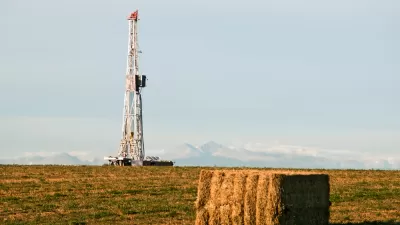Despite only applying to Federal lands where a small amount of fracking takes place, energy companies are strongly opposed, perhaps fearing that states without fracking rules could adopt them, which is one of the goals of the Interior Department.
The trade groups [Independent Petroleum Association of America and Western Energy Alliance] said the new rules are a “reaction to unsubstantiated concerns” and should be thrown out. Interior Department officials said they expect the rules to withstand challenges. [See IPAA's press release].
While only 11 percent of gas and 5 percent of oil fracking takes place on federal, including tribal lands, according to Harder and Gilbert, "states and companies could move to bring their practices in line with the U.S. (rules)." Major "energy-producing states such as Colorado, North Dakota, Pennsylvania and Texas regulate fracking already, there have been no overarching standards."
For environmental groups, the limited disclosure of chemicals used in the fracking process was disappointing. Rather than disclosure to the Interior Department where they would be accessible to the public, "the new rules require companies to publicly disclose chemicals they use through an industry-run website called FracFocus within 30 days of completing the fracking process," write Harder and Gilbert.
“While this proposal has improved from previous versions, it represents a missed opportunity to set a high bar for protections that would truly increase transparency and reduce the impacts,” said Madeleine Foote, legislative representative for the League of Conservation Voters. [See their press release].
Amy Harder explains the new rules in a one-on-one interview with PBS NewsHour's Hari Sreenivasan on Friday's show.
Correspondent's note: Subscriber-only content to The Wall Street Journal article may be available to non-subscribers for up to seven days after March 21.
FULL STORY: Fracking Rules Unveiled by Obama Administration

Study: Maui’s Plan to Convert Vacation Rentals to Long-Term Housing Could Cause Nearly $1 Billion Economic Loss
The plan would reduce visitor accommodation by 25,% resulting in 1,900 jobs lost.

North Texas Transit Leaders Tout Benefits of TOD for Growing Region
At a summit focused on transit-oriented development, policymakers discussed how North Texas’ expanded light rail system can serve as a tool for economic growth.

Why Should We Subsidize Public Transportation?
Many public transit agencies face financial stress due to rising costs, declining fare revenue, and declining subsidies. Transit advocates must provide a strong business case for increasing public transit funding.

How to Make US Trains Faster
Changes to boarding platforms and a switch to electric trains could improve U.S. passenger rail service without the added cost of high-speed rail.

Columbia’s Revitalized ‘Loop’ Is a Hub for Local Entrepreneurs
A focus on small businesses is helping a commercial corridor in Columbia, Missouri thrive.

Invasive Insect Threatens Minnesota’s Ash Forests
The Emerald Ash Borer is a rapidly spreading invasive pest threatening Minnesota’s ash trees, and homeowners are encouraged to plant diverse replacement species, avoid moving ash firewood, and monitor for signs of infestation.
Urban Design for Planners 1: Software Tools
This six-course series explores essential urban design concepts using open source software and equips planners with the tools they need to participate fully in the urban design process.
Planning for Universal Design
Learn the tools for implementing Universal Design in planning regulations.
Ascent Environmental
Borough of Carlisle
Institute for Housing and Urban Development Studies (IHS)
City of Grandview
Harvard GSD Executive Education
Toledo-Lucas County Plan Commissions
Salt Lake City
NYU Wagner Graduate School of Public Service



























